If you’ve ever seen steam billowing from under your car’s hood or watched the temperature gauge shoot into the red, you know the panic of an overheating engine. In those moments, your instinct might be to grab a bottle of coolant and pour it in as quickly as possible. But can you actually add coolant to a hot engine? The short answer is: not immediately. It could be risky for you and your car if you don’t take the right safeguards.
Let’s break it down.
Can I Add Coolant to a Hot Engine?
Why Engines Overheat
Engines produce a lot of heat when running, and the cooling system’s job is to regulate that temperature to prevent damage. Coolant, a mixture of antifreeze and water, circulates through the engine and radiator, helping absorb and dissipate heat.
When the cooling system fails — due to low coolant levels, a broken water pump, a stuck thermostat, or a leaking radiator — the engine can quickly overheat. That’s when things can get serious. Driving with an overheated engine can warp components, blow the head gasket, or even crack the engine block.
The Perils of Coolant Adding to a Hot Engine
When an engine overheats, the coolant inside it is usually boiling. Coolant can frequently reach temperatures beyond 250°F (121°C), which is significantly higher than the boiling point of water, while under pressure. If you try to remove the radiator cap or coolant reservoir cap while the engine is still hot, that pressure can release explosively, spraying scalding coolant and steam. This can cause serious burns.
Additionally, rapidly introducing cold coolant into a hot engine can cause thermal shock — a sudden change in temperature that might crack the engine block or warp metal components.
Must Read: Are All GM 3.6 Engines The Same?

What You Should Do Instead
If your engine overheats, here’s a safer step-by-step approach:
- Pull Over Safely and Turn Off the Engine
Find a safe spot to stop and turn off the engine as soon as you see overheating, which is typically indicated by a warning light or temperature gauge. Allowing it to continue operating could result in irreversible harm. - Pop the Hood, But Don’t Open the Radiator Cap
Opening the hood allows heat to escape more quickly. However, don’t touch the radiator cap or coolant reservoir just yet — it’s still under pressure. - Wait At Least 30 Minutes
Let the engine cool down. This can take 30 minutes or more. As it cools, pressure in the system will drop, reducing the risk of burns. If you’re in a hurry, you can speed this up slightly by turning the key to “ON” (not starting the engine) and setting the heater to full blast — this can help dissipate some engine heat. - Check Coolant Levels Once It’s Cool
After at least 30 minutes, check if the engine is cool to the touch. Use a thick cloth to carefully open the radiator cap or reservoir cap. If coolant is low or empty, slowly add a 50/50 mix of coolant and water to the appropriate reservoir. - Restart the Engine and Monitor
Once you’ve added coolant, start the engine and let it idle while watching the temperature gauge. If it returns to normal, you’re probably okay to drive to a repair shop. If it overheats again quickly, have it towed — something more serious may be wrong.
Emergency Coolant Top-Up Tips
If you’re stranded without coolant, you can temporarily add distilled water in an emergency. It won’t protect against freezing or boiling as well as proper coolant, but it can help cool things down enough to get you to a mechanic. Tap water can harm your cooling system, so never use it for an extended period of time.
Preventing Overheating in the First Place
Regular maintenance is the best defense against this entire situation:
- Check your coolant level monthly.
- Flush and replace coolant as recommended (usually every 2–5 years).
- Keep an eye out for leaks or puddles under your car.
- Replace worn hoses or belts.
Final Thoughts
While it might be tempting to add coolant immediately to a hot engine, doing so can be risky. Always allow the engine to cool before adding coolant, and take precautions to avoid burns or further damage. If in doubt, it’s better to call roadside assistance than to risk injury or more expensive repairs.
Your car’s cooling system is critical — treat it with care, and it’ll keep your engine running smoothly for years to come.
